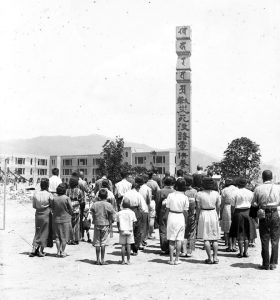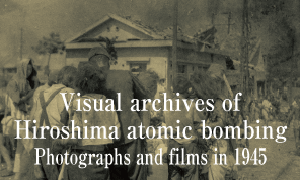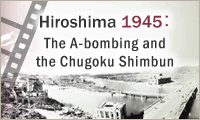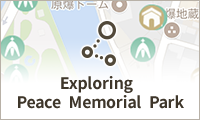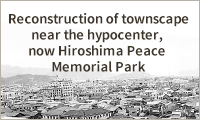Documenting Hiroshima 80 years after A-bombing: June 6, 2025, monthly memorial service for A-bomb victims held at Atomic Bomb Memorial Mound
Jun. 16, 2025
Continuous remembrance of victims
by Minami Yamashita and Yuji Yamamoto, Staff Writers
On June 6, 2025, Yoshitaka Taira, 43, deputy chief priest of Saioji Temple, located in Hiroshima City’s Naka Ward, recited Buddhist sutras for the monthly memorial service for A-bomb victims in front of the Atomic Bomb Memorial Mound, in Peace Memorial Park in the same Naka Ward. After offering prayers in remembrance of countless victims, Mr. Taira addressed approximately 10 participants in the service. “A weapon is a tool to kill people. If it is described as ‘a tool to protect people,’ the possibility exists that the weapon will become uncontrollable.”
“This is fate”
Saioji Temple is located in Hiroshima’s Nakajima-cho area just to the south of Peace Park across from Peace Boulevard. In the atomic bombing 80 years ago, the temple buildings were completely demolished and Mr. Taira’s great-grandmother was killed. After being demobilized by the military, his grandfather returned to Hiroshima and rebuilt the temple. On the grounds of the temple remain gravestones said to have been chipped at the time of the atomic bombing.
In December of last year, Mr. Taira learned of a group of citizens conducting a monthly memorial service at the mound that was looking for a successor priest to chant sutras for the service. The group inquired of him about whether he would be interested in taking over the job. He wondered whether he had the ability to do the job following in the footsteps of Nobuharu Kikkawa, who had continued the service for more than 60 years. However, he ultimately decided to accept the offer, thinking, “This is fate.”
Prior to starting the sutra-chanting work on January 6, he listened once more to the story from his parents about how Saioji Temple had been damaged in the atomic bombing. On June 6, after six months had passed, he said, “I still worry about the such details as the volume of my voice.” He thinks deeply about the significance of conducting a memorial service at the Memorial Mound, based on the idea that, “The monthly memorial service will lead to the victims never being forgotten.”
Minoru Hataguchi, 79, former director of the Hiroshima Peace Memorial Museum who lives in Hatsukaichi City, was also in attendance at the memorial service on June 6. Mr. Hataguchi was previously involved in such museum projects as an exhibition about the atomic bombing held in India. “I assume my father’s remains are also inside the mound,” he said. He experienced the atomic bombing in his mother’s womb as an in-utero survivor 80 years ago. His father, who was out of the house and working next to Hiroshima Station, went missing after the bombing.
Among the remains of around 70,000 victims interred in the Memorial Mound, those of 813 have not been claimed by bereaved family members despite their names having been identified. The name of Mr. Hataguchi’s father is not included among those that have been identified. Even if his father is among the vast majority of the others, the remains have all been placed into different sized wooden boxes with unknown identities. With that, there are no clues that he can use to identify his father.
Now, Mr. Hataguchi serves as chair of the Hiroshima Society for Praying for the War Victims, a group that manages the Memorial Mound. When bereaved family members that will accept the remains stored in the mound are identified, Mr. Hataguchi is on hand to witness the return of the remains to the families. He said, “I hope all the remains of the victims can be returned to bereaved families,” but in recent years that has happened for only a few. He bowed his head during the memorial service, swallowing his own bitter regrets.
Events for listening to testimonies of A-bombing experiences
On June 6, the same day, Soh Horie, 84, an A-bomb survivor living in Hiroshima’s Saeki Ward who had lost his father in the bombing, spoke about his experience in the atomic bombing for around 90 minutes with three participants from Hiroshima and other prefectures sitting around a table. The venue was the Social Book Café Hachidorisha, located around a five-minute walk from Peace Memorial Park.
Events designed for listening to survivors’ testimonies are held each month on dates that include the number six, including the monthly memorial service. Compared with presentations given by survivors other locations such as the Hiroshima Peace Memorial Museum, these other events allow conversation to take place among small numbers of participants. Mr. Horie said, “The format makes it easy for me to express my feelings.”
Erika Abiko, 46, owner of the Hachidorisha café, has continuously held the event since the establishment was first opened in 2017. Ms. Abiko is originally from Ibaraki Prefecture in eastern Japan and thus did not grow up being familiar with the A-bombed city. In 2008, however, when she joined a boat cruise organized by the non-governmental organization Peace Boat, she grew close to an A-bomb survivor on board. “I came to feel that the atomic bomb had been dropped on people like my friend, which made me angry.” Since then, the issue of nuclear weapons has come to feel for her like a personal matter.
When Ms. Abiko hosts the event, she tries to produce “a sense of closeness with the A-bomb survivors, like that of friends.” To this point in time, around 20 A-bomb survivors have shared their experiences in the atomic bombing with approximately 3,000 people who have attended the event. It will continue to take place as part of the usual slate of Hiroshima events on the upcoming dates of June 16, June 26, July 6, and so on.
(Originally published on June 16, 2025)



